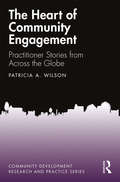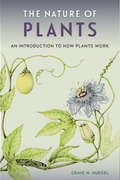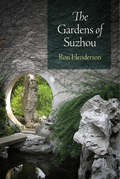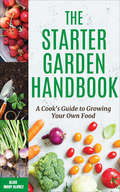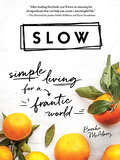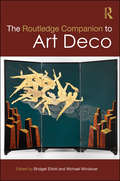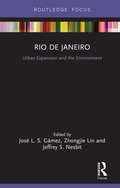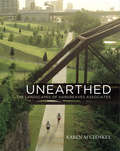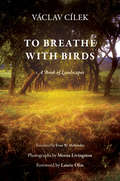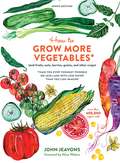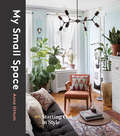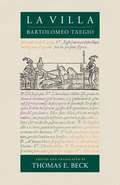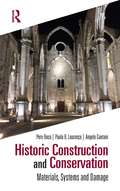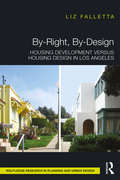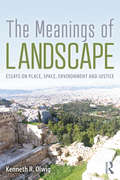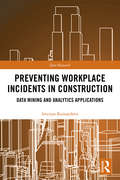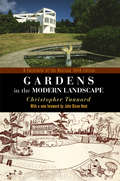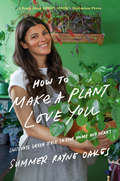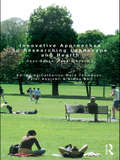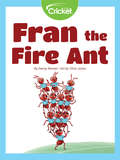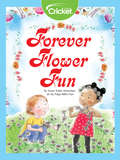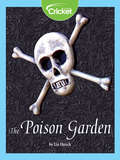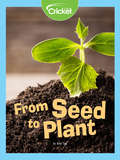- Table View
- List View
The Heart of Community Engagement: Practitioner Stories from Across the Globe (Community Development Research and Practice Series)
by Patricia A. WilsonDrawing on first-hand accounts of action research in the Americas, Africa, and Asia, The Heart of Community Engagement illustrates the transformative learning journeys of exemplary catalysts for community-based change. Practitioners’ stories of community engagement for social justice in the Global South elucidate the moments of insight and transformation that deepened their practice: how to deal with uncertainty, recognize their own blind spots, become aware of what is emergent and possible in the moment, and weave an inclusive bond of love, respect, and purpose. Each successive narrative adds a deeper level of understanding of the inner practice of community engagement. The stories illuminate the reflective, or inner, practice of the outside change agent, whether a planner, designer, participatory action researcher, or community development practitioner. From a shantytown in South Africa, to a rural community in India, or an informal settlement in peri-urban Mexico, the stories focus attention on the greatest leverage point for change that we, as engaged practitioners, have: our own self-awareness. By the end of the book, the practitioners are not only aware of their own conditioned beliefs and assumptions, but have opened their minds and hearts to the complex and dynamic patterns of emergent change that is possible. This book serves as a much-needed reader of practice stories to help instructors and students find the words, concepts, and examples to talk about their own subjective experience of community engagement practice. The book applies some of the leading-edge concepts from organizational development and leadership studies to the fields of planning, design, and community engagement practice. Key concepts include the deep dive of sensing the social field, seeing the whole, and presencing the emergent future. The book also provides a creative bridge between participatory action research and design thinking: user-based design, rapid prototyping, and learning from doing.
The Nature of Plants: An Introduction to How Plants Work
by Craig N. HuegelPlants play a critical role in how we experience our environment. They create calming green spaces, provide oxygen for us to breathe, and nourish our senses. In The Nature of Plants, ecologist and nursery owner Craig Huegel demystifies the complex lives of plants and provides readers with an extensive tour into their workings. Beginning with the importance of light, water, and soil, Huegel describes the process of photosynthesis and how best to position plants to receive optimal sunlight. He explains why plants suffer from overwatering, what essential elements plants need to flourish, and what important soil organisms reside with them. Readers will understand the difference between friendly and hostile bacteria, fungi, and insects. Sections on plant structure and reproduction focus in detail on major plant organs—roots, stems, and leaves—and cover flowering, pollination, fruit development, and seed germination. Huegel even delves into the mysterious world of plant communication, exploring the messages conveyed to animals or other plants through chemical scents and hormones. With color illustrations, photographs, and real-life examples from his own gardening experiences, Huegel equips budding botanists, ecologists, and even the most novice gardeners with knowledge that will help them understand and foster plants of all types.
The Gardens of Suzhou (Penn Studies in Landscape Architecture)
by Ron HendersonSuzhou, near Shanghai, is among the great garden cities of the world. The city's masterpieces of classical Chinese garden design, built from the eleventh through the nineteenth centuries, attract thousands of visitors each year and continue to influence international design. In The Gardens of Suzhou, landscape architect and scholar Ron Henderson guides visitors through seventeen of these gardens. The book explores UNESCO world cultural heritage sites such as the Master of the Nets Garden, Humble Administrator's Garden, Lingering Garden, and Garden of the Peaceful Mind, as well as other lesser-known but equally significant gardens in the Suzhou region.Unlike the acclaimed religious and imperial gardens found elsewhere in Asia, Suzhou's gardens were designed by scholars and intellectuals to be domestic spaces that drew upon China's rich visual and literary tradition, embedding cultural references within the landscapes. The elements of the gardens confront the visitor: rocks, trees, and walls are pushed into the foreground to compress and compact space, as if great hands had gathered a mountainous territory of rocky cliffs, forests, and streams, then squeezed it tightly until the entire region would fit into a small city garden.Henderson's commentary opens Suzhou's gardens, with their literary and musical references, to non-Chinese visitors. Drawing on years of intimate experience and study, he combines the history and spatial organization of each garden with personal insights into their rockeries, architecture, plants, and waters. Fully illustrated with newly drawn plans, maps, and original photographs, The Gardens of Suzhou invites visitors, researchers, and designers to pause and observe astonishing works from one of the world's greatest garden design traditions.
Styled: Secrets for Arranging Rooms, from Tabletops to Bookshelves
by Emily Henderson Angelin BorsicsThe ultimate guide to thinking like a stylist, with 1,000 design ideas for creating the most beautiful, personal, and livable roomsIt's easy to find your own style confidence once you know this secret: While decorating can take months and tons of money, styling often takes just minutes. Even a few little tweaks can transform the way your room feels. At the heart of Styled are Emily Henderson's ten easy steps to styling any space. From editing out what you don't love to repurposing what you can't live without to arranging the most eye-catching vignettes on any surface, you'll learn how to make your own style magic. With Emily's insider tips and more than 1,000 unique ideas from 75 envy-inducing rooms, you'll soon be styling like you were born to do it.
The Starter Garden Handbook: A Cook's Guide to Growing Your Own Food
by Alice Mary AlvrezThe author of The Going Green Handbook gives you tips for growing vegetables, reducing your food budget, eating organic, and being eco-friendly. Here in one pretty package is everything you need to know to have your garden and eat it, too! Inside, you’ll find tips for greening up all areas of your garden. Learn surprising facts about your impact on the environment and change your habits with do-it-yourself ideas in The Starter Garden Handbook. Organic gardener, environmentalist, and pop-up chef Alice Mary Alvrez will help you start with small changes, like growing basic herbs, and work your way up to raising bees. Learn how to raise many kinds of vegetables and fruits, and get tips on composting weeds, clippings, and leftovers so you have nutrient-rich soil. Whether you are at the green rookie level, eco-master, or full-on gardening guru, you can learn to grow your own food and help the planet every week of the year with The Starter Garden Handbook. If you’re a fan of The Vegetable Gardener’s Bible, you’ll love The Starter Garden Handbook! “Nowadays people think they have to quit their day job and toil in the hot sun all day. Not true! Most gardening is in the planning and once you have established your plot, I promise you, it will become your Happy Place. Nothing feels better than serving a delicious dish from plants you grew from seeds.” —Susannah Seton, author of Simple Pleasures of the Garden
Slow: Simple Living for a Frantic World
by Brooke McAlaryFree yourself from the frantic and embrace the joy of slow..."After reading this book, you'll have an amazing list of ingredients that can help you create a meaningful life, too!" —The Minimalists Joshua Fields Millburn and Ryan Nicodemus"Finally, a slow living guide for the imperfect folks . . . Brooke McAlary's exuberant, honest words are a refreshing contribution to the slow living community. If you're seeking a simpler path, start here." —Erin Loechner, Blogger at DesignforMankind.com and author of Chasing SlowAre you constantly striving to keep up with life's busy expectations? It's easy to feel consumed with the desire to "succeed" and "acquire", and miss the simple opportunities waiting for you to slow down: a walk in the forest, sharing laughter with family, a personal moment of gratitude...Once upon a time, it became clear to Brooke McAlary that the key to happiness was discovering a simpler, more fulfilling existence. She put the brakes on her stressful path, and reorganized her life to live outside the status-quo, emphasizing depth, connection and meaningful experiences. Alongside Brooke's affirming personal stories of breaking down and rising up, Slow provides practical advice and fascinating insights into the benefits and challenges of the slow life, such as: —Decluttering to de-owning—Messiness to mindfulness—Asking why, to asking where to now?Slow is an inspirational guide on creating a life filled with the things that really matter, and is meant for anyone seeking peace, meaning, and joy in their otherwise rapid lives. Slowly—of course.
The Routledge Companion to Art Deco (Routledge Art History and Visual Studies Companions)
by Bridget Elliott Michael WindoverScholarly interest in Art Deco has grown rapidly over the past fifty years, spanning different academic disciplines. This volume provides a guide to the current state of the field of Art Deco research by highlighting past accomplishments and promising new directions. Chapters are presented in five sections based on key concepts: migration, public culture, fashion, politics, and Art Deco’s afterlife in heritage restoration and new media. The book provides a range of perspectives on and approaches to these issues, as well as to the concept of Art Deco itself. It highlights the slipperiness of Art Deco yet points to its potential to shed new light on the complexities of modernity.
Rio de Janeiro: Urban Expansion and the Environment (Built Environment City Studies)
by José L. S. Gámez Zhongjie Lin Jeffrey S. NesbitUsing Rio de Janeiro as the case study city, this book highlights and examines issues surrounding the development of mega-cities in Latin America and beyond. Complex dynamics of urbanization such as mega-event-driven development, infrastructure investment, and informal urban expansion are intertwined with changing climatic conditions that demand new approaches to sustainable urbanism. The urban conditions facing 21st century cities such as Rio emphasize the need to revisit urban forms, reintegrate infrastructure, and re-evaluate practices. With contributions from 15 scholars from several countries exploring urbanism, urbanization, and climate change, this book provides insights into the contextual and environmental issues shaping Rio in the age of globalization. Each of the book’s three sections addresses an interdisciplinary range of topics impacting urbanism in Latin America, which will be accessible to researchers and professionals interested in urbanization, urban design, sustainability, planning, and architecture.
Unearthed: The Landscapes of Hargreaves Associates (Penn Studies in Landscape Architecture)
by Karen M'CloskeyThe work of landscape architecture firm Hargreaves Associates is globally renowned, from the 21st Century Waterfront in Chattanooga, Tennessee, to London's 2012 Olympic Park. Founded by George Hargreaves in 1983, this team of designers has transformed numerous abandoned sites into topographically and functionally diverse landscapes. Hargreaves Associates' body of work reflects the socioeconomic and legislative changes that have impacted landscape architecture over the past three decades, particularly the availability of former industrial sites and their subsequent redevelopment into parks. The firm's longstanding interest in such projects brings it into frequent contact with the communities and local authorities who use and live in these built environments, which tend to be contested grounds owing to the conflicting claims of the populations and municipalities that use and manage them. As microcosms of contemporary political, social, and economic terrains, these designed spaces signify larger issues in urban redevelopment and landscape design.The first scholarly examination of the firm's philosophy and body of work, Unearthed uses Hargreaves Associates' portfolio to illustrate the key challenges and opportunities of designing today's public spaces. Illustrated with more than one hundred and fifty color and black-and-white images, this study explores the methods behind canonical Hargreaves Associates sites, such as San Francisco's Crissy Field, Sydney Olympic Park, and the Louisville Waterfront Park. M'Closkey outlines how Hargreaves and his longtime associate Mary Margaret Jones approach the design of public places—conceptually, materially, and formally—on sites that require significant remaking in order to support a greater range of ecological and social needs.
To Breathe with Birds: A Book of Landscapes (Penn Studies in Landscape Architecture)
by Václav CílekJust as there is love at first sight between people, Václav Cílek writes, there can be love at first sight between a person and a place. A landscape is more than a location, it is one party in a relationship—even when the spirit of a certain setting is not perceptible to those who visit. But whether we travel to experience rapture or excitement, to discover truth and beauty, or to be dazzled, we search for the essence of faraway landscapes to gain perspective on our own place within the world. To Breathe with Birds delves into the imaginative and emotional bonds we form with landscapes and how human existence—a recent development, geologically speaking—shapes and is shaped by a sense of place.In subtle and lyrical prose, renowned geologist and author Václav Cílek explores topics from the history of asphalt to the spirits we imagine in trees, from geodiversity to the mathematics of snowflakes. Weaving earth science and environmentalism together with memoir and myth, his chapters visit resonant locations from India to Massachusetts, though most are deeply rooted in the river-laced, war-scarred landscape of Cílek's Czech homeland. These reflections are accompanied by Morna Livingston's evocative photographs, which capture the beauty and strangeness of natural and human-made forms. The first book-length appearance of Cílek's work in English translation, To Breathe with Birds offers insightful perspectives on the symbolism of landscapes as we struggle to conserve and protect the depleted earth.
How to Grow More Vegetables, Ninth Edition: (and Fruits, Nuts, Berries, Grains, and Other Crops) Than You Ever Thought Possible on Less Land with Less Water Than You Can Imagine
by John JeavonsThe world's leading resource on biointensive, sustainable, high-yield organic gardening is thoroughly updated throughout, with new sections on using 12 percent less water and increasing compost power. Long before it was a trend, How to Grow More Vegetables brought backyard ecosystems to life for the home gardener by demonstrating sustainable growing methods for spectacular organic produce on a small but intensive scale. How to Grow More Vegetables has become the go-to reference for food growers at every level, whether home gardeners dedicated to nurturing backyard edibles with minimal water in maximum harmony with nature's cycles, or a small-scale commercial producer interested in optimizing soil fertility and increasing plant productivity. In the ninth edition, author John Jeavons has revised and updated each chapter, including new sections on using less water and increasing compost power.
My Small Space: Starting Out in Style
by Anna OttumMy Small Space is the ultimate guide to moving out on your own--whether that's in a campus dorm, an apartment with four of your friends, a two-bedroom with your buddy, or your very own studio. With photography of all kinds of spaces, smart design tips, interviews with renters, and more, this book proves that size doesn't matter when you have great style.Learn how to decorate around immovable furniture in a dorm and what to pack (and leave behind) from home. Get creative in a cramped apartrment that you share with others. If you're thinking about living solo, see what it's like to finally be in control of all of the decision making. With tips on making floor plans, picking out color palettes, hanging wall art, choosing a rug, and more, this lookbook will help you feel right at home--wherever that may be.
La Villa: Dialogo (classic Reprint) (Penn Studies in Landscape Architecture)
by Bartolomeo TaegioPublished in 1559 and appearing here for the first time in English, La Villa is a rare source of Renaissance landscape theory. Written by Bartolomeo Taegio, a Milanese jurist and man of letters, after his banishment (possibly for murder, Thomas E. Beck speculates), the text takes the form of a dialogue between two gentlemen, one a proponent of the country, the other of the city. While it is not a gardening treatise, La Villa reflects an aesthetic appreciation of the land in the Renaissance, reveals the symbolic and metaphorical significance of sixteenth-century gardens for their owners, and articulates a specific philosophy about the interaction of nature and culture in the garden.This edition of the original Italian text and Beck's English translation is augmented with notes in which Beck identifies numerous references to literary sources in La Villa and more than 280 people and places mentioned in the dialogue. The introduction illuminates Taegio's life and intellectual activity, his obligations to his sources, the cultural context, and the place of La Villa in Renaissance villa literature. It also demonstrates the enduring relevance of La Villa for architecture and landscape architecture. La Villa makes a valuable contribution to the body of literature about place-making, precisely because it treats the villa as an idea and not as a building type.
Historic Construction and Conservation: Materials, Systems and Damage
by Pere Roca Paulo B. Lourenço Angelo GaetaniConservation in the built environment raises fundamental questions which have been debated for centuries - what is worth preserving, how is it possible, why is it important? This book takes a modern approach to the meaning of a heritage structure and its conservation. The historical evolution of conservation is briefly addressed, considering prominent individuals and cases; along with the history of construction, focusing on materials and related structural elements, with insight on the sizing rules adopted by masons. This explains structural decisions made during the construction process and allows comparison of scientific theories from the 18th century to modern understanding of limit analysis. Damage and collapse mechanisms for masonry construction, as the most widespread structural form for historical buildings, is described. Excess permanent loading and settlement is differentiated from environmental and anthropogenic actions such as earthquake or incorrect intervention. The team of authors brings together unique expertise, with high level research and leading practice with archetypical cases from around the world. The book addresses the history of conservation by exploring materials and structures and the history of construction and damage, so it is of value to students and professionals in civil engineering and architecture, as well as archaeologists and art historians.
By-Right, By-Design: Housing Development versus Housing Design in Los Angeles
by Liz FallettaHousing is an essential, but complex, product, so complex that professionals involved in its production, namely, architects, real estate developers and urban planners, have difficulty agreeing on “good” housing outcomes. Less-than-optimal solutions that have resulted from a too narrow focus on one discipline over others are familiar: high design that is costly to build that makes little contribution to the public realm, highly profitable but seemingly identical “cookie-cutter” dwellings with no sense of place and well-planned neighborhoods full of generically designed, unmarketable product types. Differing roles, languages and criteria for success shape these perspectives, which, in turn, influence attitudes about housing regulation. Real estate developers, for example, prefer projects that can be built “as-of-right” or “by-right,” meaning that they can be approved quickly because they meet all current planning, zoning and building code requirements. Design-focused projects, heretofore “by-design,” by contrast, often require time to challenge existing regulatory codes, pursuing discretionary modifications meant to maximize design innovation and development potential. Meanwhile, urban planners work to establish and mediate the threshold between by-right and by-design processes by setting housing standards and determining appropriate housing policy. But just what is the right line between “by-right” and “by-design”? By-Right, By-Design provides a historical perspective, conceptual frameworks and practical strategies that cross and connect the diverse professions involved in housing production. The heart of the book is a set of six cross-disciplinary comparative case studies, each examining a significant Los Angeles housing design precedent approved by-variance and its associated development type approved as of right. Each comparison tells a different story about the often-hidden relationships among the three primary disciplines shaping the built environment, some of which uphold, and others of which transgress, conventional disciplinary stereotypes.
Oranges For Orange Juice (Social Studies Learn To Read)
by Rozanne Williams Craig BrownRepetitive, predictable story lines and illustrations that match the text provide maximum support to the emergent reader. Engaging stories promote reading comprehension, and easy and fun activities on the inside back covers extend learning. Great for Reading First, Fluency, Vocabulary, Text Comprehension, and ESL/ELL!
The Meanings of Landscape: Essays on Place, Space, Environment and Justice
by Kenneth R. OlwigCompiling eighteen authoritative essays spanning an extensive academic career, author Kenneth R. Olwig presents explorations in landscape geography and architecture from an environmental humanities perspective. With influences from art, literature, theatre staging, architecture, and garden design, landscape has come to be viewed as a form of spatial scenery, but this reading captures only a narrow representation of landscape meaning today. This book positions landscape as a concept shaped through the centuries, evolving from place to place to provide nuanced interpretations of landscape meaning. The essays are woven together to gather an international approach to understanding the past and present importance of landscape as place and polity, as designed space, as nature, and as an influential factor in the shaping of ideas in a just social and physical environment. Aimed at students, scholars, and researchers in landscape and beyond, this illustrated volume traces the idea of landscape from the ancient polis and theatre through to the present day.
Preventing Workplace Incidents in Construction: Data Mining and Analytics Applications (Spon Research)
by Imriyas KamardeenThe construction industry is vital to any national economy; it is also one of the industries most susceptible to workplace incidents. The unacceptably high rates of incidents in construction have huge socio-economic consequences for the victims, their families and friends, co-workers, employers and society at large. Construction safety researchers have introduced numerous strategies, models and tools through scientific inquiries involving primary data collection and analyses. While these efforts are commendable, there is a huge potential to create new knowledge and predictive models to improve construction safety by utilising already existing data about workplace incidents. In this new book, Imriyas Kamardeen argues that more sophisticated approaches need to be deployed to enable improved analyses of incident data sets and the extraction of more valuable insights, patterns and knowledge to prevent work injuries and illnesses. The book aims to apply data mining and analytic techniques to past workplace incident data to discover patterns that facilitate the development of innovative models and strategies, thereby improving work health, safety and well-being in construction, and curtailing the high rate of incidents. It is essential reading for researchers and professionals in construction, health and safety and anyone interested in data analytics.
Gardens in the Modern Landscape: A Facsimile of the Revised 1948 Edition (Penn Studies in Landscape Architecture)
by Christopher TunnardBetween 1937 and 1938, garden designer Christopher Tunnard published a series of articles in the British Architectural Review that rejected the prevailing English landscape style. Inspired by the principles of Modernist art and Japanese aesthetics, Tunnard called for a "new technique" in garden design that emphasized an integration of form and purpose. "The functional garden avoids the extremes both of the sentimental expressionism of the wild garden and the intellectual classicism of the 'formal' garden," he wrote; "it embodies rather a spirit of rationalism and through an aesthetic and practical ordering of its units provides a friendly and hospitable milieu for rest and recreation."Tunnard's magazine pieces were republished in book form as Gardens in the Modern Landscape in 1938, and a revised second edition was issued a decade later. Taken together, these articles constituted a manifesto for the modern garden, its influence evident in the work of such figures as Lawrence Halprin, Philip Johnson, and Edward Larrabee Barnes.Long out of print, the book is here reissued in a facsimile of the 1948 edition, accompanied by a contextualizing foreword by John Dixon Hunt. Gardens in the Modern Landscape heralded a sea change in the evolution of twentieth-century design, and it also anticipated questions of urban sprawl, historic preservation, and the dynamic between the natural and built environments. Available once more to students, practitioners, and connoisseurs, it stands as a historical document and an invitation to continued innovative thought about landscape architecture.
How to Make a Plant Love You: Cultivate Green Space in Your Home and Heart
by Summer Rayne OakesSummer Rayne Oakes, an urban houseplant expert and environmental scientist, is the icon of wellness-minded millennials who want to bring nature indoors, according to a New York Times profile. Summer has managed to grow 1,000 houseplants in her Brooklyn apartment (and they're thriving!) Her secret? She approaches her relationships with plants as intentionally as if they were people.Everyone deserves to feel the inner peace that comes from taking care of greenery. Beyond the obvious benefits--beauty and cleaner air--there's a strong psychological benefit to nurturing plants as a path to mindfulness. They can reduce our stress level, lower our blood pressure, and improve our overall outlook. And they offer a rare opportunity to find joy by caring for another living being. When Summer Rayne Oakes moved to Brooklyn from the Pennsylvania countryside, she knew that bringing nature indoors was her only chance to stay sane. She found them by the side of the road, in long-forgotten window boxes, at farmers' markets, and in local garden shops. She found ways to shelve, hang, tuck, anchor, secure, and suspend them. She even installed 150-foot expandable hose that connects to pipes under her kitchen sink, so she only has to spend about a half-hour a day tending to her plants--an activity that she describes as a "moving meditation." This is Summer's guidebook for cultivating an entirely new relationship with your plant children. Inside, you'll learn to: * Pause for the flowers and greenery all around you, even the ones sprouting bravely between cracked pavement * Trust that your apartment jungle offers you far more than pretty décor * See the world from a plant's perspective, trading modern consumerism for sustainability * Serve your chlorophyllic friends by learning to identify the right species for your home and to recreate their natural habitat (Bonus: your indoor garden won't die!)When we become plant parents, we also become better caretakers of ourselves, the people around us, and our planet. So, let's step inside the world of plants and discover how we can begin cultivating our own personal green space--in our homes, in our minds, and in our hearts.
Innovative Approaches to Researching Landscape and Health: Open Space: People Space 2
by Catharine Ward Thompson Peter Aspinall Simon BellOur modern lifestyles often cause us to spend more time sitting behind a desk than being active outdoors. At the same time, our general health is deteriorating. The alarming rise in obesity, sedentary lifestyles and mental ill-health across the developed world has resulted in an urgent desire to understand how the environment, in particular the outdoor environment, influences health. This book addresses the growing interest in salutogenic environments - landscapes that support healthy lifestyles and promote well-being – and the need for innovative methods to research them. Drawing on multidisciplinary approaches from environmental psychology, health sciences, urban design, landscape architecture and horticulture, it questions how future research can be better targeted to inform policy and practice in health promotion. The contributing authors are international experts in researching landscape, health and the environment, drawn together by OPENspace directors who have a unique reputation in this area. This pioneering book is a valuable resource for postgraduate researchers and practitioners in both environmental and health studies.
Fran the Fire Ant
by Chris Jones Danny ResnerFran is a fire ant with a very important job—she’s a nurse ant! When the nest’s queen lays eggs, it’s the nurse ants’ job to raise the eggs into larvae and pupae so they grow up to become healthy worker ants to help build and run the nest.
Forever Flower Fun
by Susan Yoder AckermanThere are so many fun things to do outside during the summer! When the flowers bloom, there is flower fun for everyone! When their hollyhock ladies and daisy chains wilt, Lily Rose and her friend learn how to preserve flowers by drying them. There's always an adventure in nature!
The Poison Garden
by Liz HuyckFlowers may look pretty, but some can be downright deadly! In England, you can explore the Poison Garden—a place where flowers are known for their beauty on the outside and poison on the inside! In this story, you'll be able to read about and see these flowers safely without interacting with them.
From Seed to Plant
by Amy TaoInside every seed waits a tiny plant, ready to grow. Watch the process of a pumpkin plant from tiny seed to full-size fruit! You'll also see other plant seeds, which come in many different sizes, shapes, and colors. Some can be as big as your head, but poppy seeds are so little you can hold hundreds in one hand!
